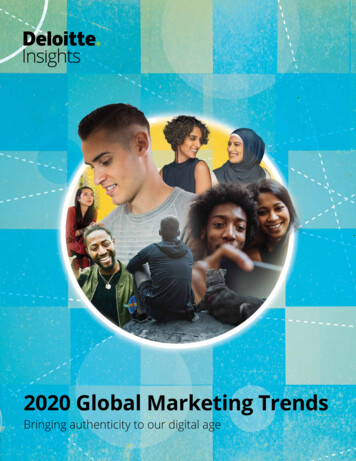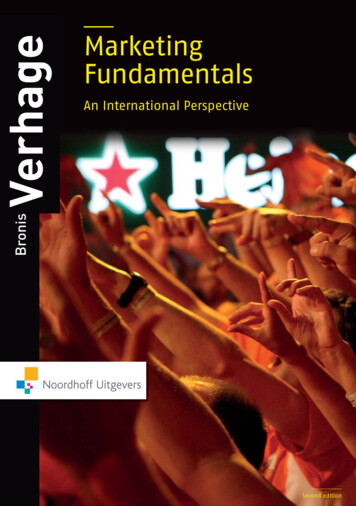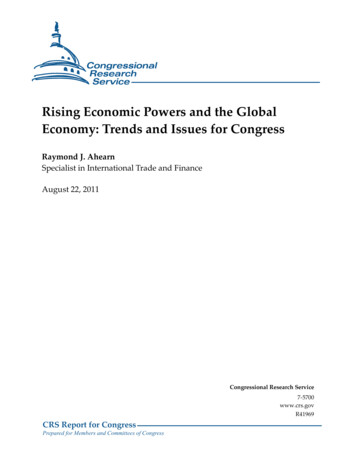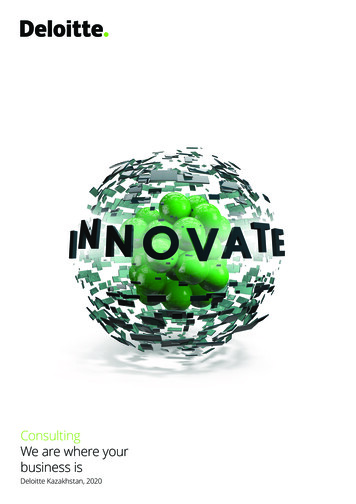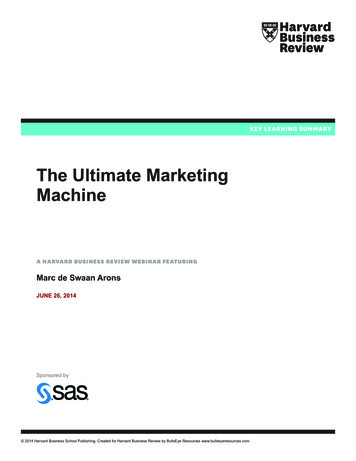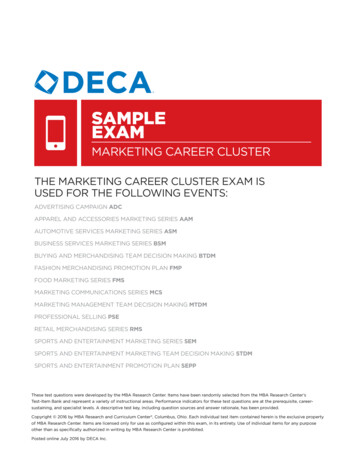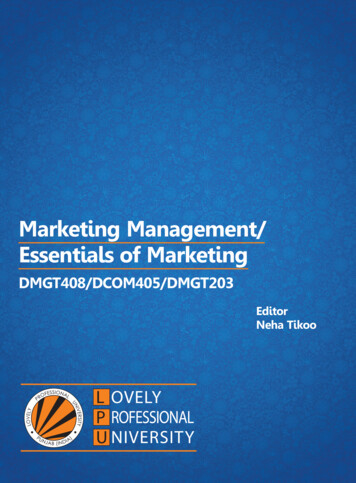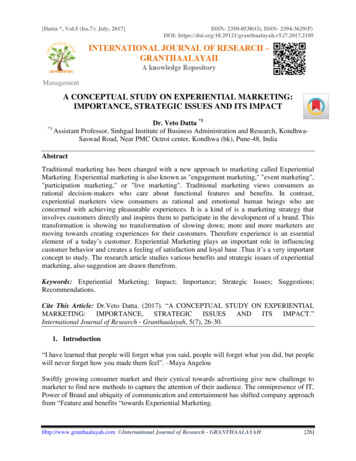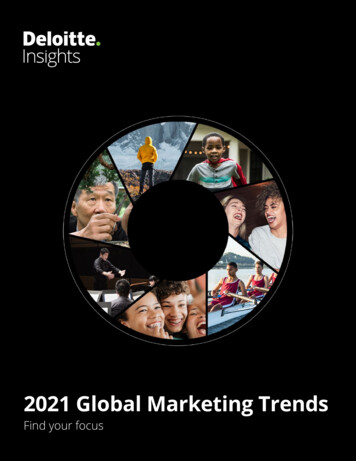
Transcription
2021 Global Marketing TrendsFind your focus
About the Deloitte CMO ProgramDeloitte’s CMO Program supports CMOs as they navigate the complexities of the role, anticipateupcoming market trends, and respond to challenges with agile marketing.Read more on the latest marketing trends and insights.Digital technology has changed the face of business. Across the globe, Deloitte Digital helpsclients see what’s possible, identify what’s valuable, and deliver on it by combining creative anddigital capabilities with advertising agency prowess and the technical experience, deep businessstrategy, and relationships of the world’s largest consultancy. Deloitte Digital empowersbusinesses with the insights, platforms, and behaviors needed to continuously and rapidlyevolve to perform beyond expectations. Read more about Deloitte Digital’s world-class digitalagency and its service offerings.
ContentsIntroduction2Purpose: Built to flourish6Agility: Changing the playbook16Human Experience: Know thyself24Trust: The promises we keep—or don’t34Participation: A two-way street44Fusion: The new ecosystem54Talent: Marketing disrupted64
2021 Global Marketing Trends: Find your focusIntroduction2021 Global Marketing Trends: Find your focusTHROUGHOUT HISTORY, MOMENTS of crisissafely and productively; grocery shopping,and uncertainty have galvanized newdining out, education, and medical treatmentinnovations and shifted views on whatfundamentally changed. And, almost in parallel, asmatters most to people. The 1918 pandemica reckoning of systemic racism came to a head, wepopularized the use of the telephone so much thatwere forced to reassess and reflect on our valuesthe people-powered switch operators couldn’t keepand what it means to be human.up.1 In the Cold War era, the rise of televisions inhouseholds directly influenced how peopleFrom people and businesses to governments,perceived conflict at a time when the Vietnam Wareveryone needed to find new ways to navigate thisbecame the world’s “First Televised War.” And,new world—and this trends report was no different.more recently, as issues of climate change andHow do you uncover and discuss the implicationsgender equality took centerstage, people began toof global marketing trends at a time when thedemand more from businesses.3world has seemingly turned on its axis and still2continues to change in unpredictable ways?Now, we are confronted with an amalgamation ofuncertainty—and the world is collectively lookingTo seek an answer to this question, we set out onfor answers. With an omnipresent pandemic, wean all-encompassing journey to better understandhad to find new ways to socialize in a world wherehow people and brands responded to thesocial distancing quickly became the norm; workpandemic—and, most importantly, why somehad to be redesigned so people could do their jobsbrands were able to flourish even during theseTHE 2021 GLOBAL MARKETING TRENDS STUDYAs our world went through rapid changes, we recognized a need to dig deeper into the evolvingmilieu to better understand how consumers and executives are responding to their newenvironments. With this in mind, we conducted two surveys to inform each of the 2021 GlobalMarketing Trends chapters.The Global Marketing Trends Consumer Pulse Survey polled 2,447 global consumers, ages 18and above, in April 2020. This survey was launched in the United States, the United Kingdom, Mexico,China, South Africa, Qatar, the United Arab Emirates, and the Kingdom of Saudi Arabia.The Global Marketing Trends C-suite Survey polled 405 US C-suite executives from globalcompanies in May 2020. This survey asked CMOs, CFOs, COOs, and CHROs their thoughts ona variety of topics related to their response to COVID-19.2
Introductionturbulent times. In our second annual report, wethe pandemic, the majority prioritized improvingcombine subject matter expertise, voices from theefficiency and productivity over more human-field, and two overarching surveys—one consumer-centric initiatives such as strengthening customerbased and the other targeted toward executives—toengagement, retaining talent, and increasing theseparate the signals from the noise of change (seecompany’s impact on society. And in thesethe sidebar, “The 2021 Global Marketing Trendsmoments of high stress and low certainty, almoststudy” to learn more).no one was thinking about growing revenues ordisrupting their industry.Even among executives, our research found they’reAnswering the call for helpfeeling the pressure of an uncertain future. Forinstance, 18 months ago, we polled executives ontheir ability to influence their peers and make aOf course, this isn’t unprecedented or unexpectedstrategic impact.4 When we asked 405 executivesbehavior, but when we polled consumers, theythe same questions in May of 2020, we sawshowed us that as times get tougher, they expectC-suite confidence has plummeted across themore from the brands they frequent. Consider theboard (figure 1).following findings from our consumer survey:As often is the case when we are unsure of how to Almost four in five people could cite a time arespond, our most basic instincts kick in and webrand responded positively to the pandemicprioritize survival over human connection andand one in five strongly agreed it led togrowth. When we asked these executives whatincreased brand loyalty on their part.outcomes they hoped to achieve in responding toFIGURE 1C-suite executives have all seen a significant drop in confidencePercentage of confident executives20192020 (post Source: Deloitte Global Marketing Trends C-suite Survey.Deloitte Insights deloitte.com/insights3
2021 Global Marketing Trends: Find your focus Conversely, more than 25% of those whoorganizations should be deeply attuned to why theynoticed brands acting in their own self-interestexist and who they are built to serve.walked away from those brands.Our second chapter, Agility, explores how More than 70% agreed they valued digitalorganizations can best structure themselves to notsolutions that deepened their connection withonly live out this purpose, but also to do so asother people, and 63% believe they will rely onstakeholder needs unfold.digital technologies more than they did prior toThe Human Experience chapter explores howthe pandemic even well after it subsides.organizations can break out of their efficiency-first Fifty-eight percent of respondents could recallmindsets to elevate the experiences of theirat least one brand that quickly pivoted to bettercustomers, workforces, and business partners. Inrespond to their needs, and 82% said this led toour fourth chapter, Trust, we provide a means tothem doing more business with the brand.holding brands accountable and ensuring that themessages they convey are congruent with theWhen we analyze these findings in tandem, weexperiences they deliver.see a very clear message: In these wild times ofuncertainty, people are looking to brands for help—Our fifth trend chapter, Participation, makes useand rewarding those that can meet their mostof an in-depth consumer study to highlight howpressing needs in the moment.some of the leading companies in the world areharnessing customer passion to bolster theirIn this spirit, we developed seven trends to helpengagement strategies through customer-ledexecutives break through this wall of uncertaintyinnovation and advocacy.and take action. These trends can enable leaders toOur Fusion trend sheds light on how some of therespond to customer needs as they unfold, pivotbusiness models to better align to evolving needs,most creative companies in the world were able toand foster the human connection we all crave.overcome their defensive mindsets to createentirely new solutions through the fusing ofnew partnerships, customer ideas, and digitalBreaking throughwith seven trendsecosystems.The final chapter, Talent, provides a line of sightEach of our 2021 global marketing trends sharesinto how marketing can elevate its talent modelthe common theme of breaking out of our often-into a competitive differentiator—even in thedefensive mindsets to more holistically—andtoughest of times.authentically—meet human needs.These trends do not purport to predict what theIn our opening trend chapter on Purpose, wefuture holds, but they may offer something moreestablish the foundation required to flourish inpressing: a path forward to help your customers,even the most turbulent of times. To do this,workforces, and society when, collectively, weneed it the most.4
IntroductionEndnotes1.David Cassel, “How technology helped us through the 1918 flu pandemic,” New Stack, April 12, 2020.2.Jessie Kratz, “Vietnam: The first television war,” U.S. National Archives, January 25, 2018.3.Dimple Agarwal et al., The rise of the social enterprise: 2018 Deloitte Global Human Capital Trends, DeloitteInsights, 2018.4.Diana O’Brien, Jennifer Veenstra, and Timothy Murphy, The makings of a more confident CMO: Three ways toincrease C-suite impact, Deloitte Insights, September 18, 2020.About the authorsJennifer Veenstra is the managing director of Deloitte’s Global CMO Program.She focuses on CMO leadership, especially around the client experience, drivingstrategy, and digital transformation. She works across multiple industry areas tohelp CMOs in delivering enterprise growth and connecting with customers aroundpurpose. She has led the transformation of the Deloitte Client Experience.Timothy Murphy is the director of research and insights for Deloitte’s CMOProgram. As a researcher and analytical scientist with Deloitte Services LP, hefocuses on emerging marketing trends and CMO dynamics within the C-suite.5
2021 Global Marketing Trends: Find your focusPurposeOrganizations that know whythey exist and who they’rebuilt to serve are uniquelypositioned to navigateunprecedented change.6
Purpose: Built to flourishBuilt to flourishNavigating an ever-changing worldthrough the purpose-driven enterpriseTHE WORLD HAS been through one of thestakeholders, some are positioned to remainworst crises of this century—the coronavirussteadfast in one key dimension—their purpose.pandemic—and is just beginning to pick upThese companies inherently understand why theythe pieces and rebuild itself socially andexist and who they are best built to serve—fromeconomically. As COVID-19 took its economic andtheir customers and workforces to the community—emotional toll on the world, businesses were—andregardless of what they sell today.still are—faced with myriad uncertainties. How doorganizations navigate a reality where theirPromisingly, people are taking note of these brands.products and services may no longer have the sameIn Deloitte’s survey of 2,447 global consumers, 79%standing as they did prior to the outbreak? Forof respondents recalled instances of brandssome, it may be a question of how to connect withpositively responding to COVID-19 to help theirtheir communities when storefronts are shuttered,customers, workforces, and communities (figure 1).or, in terms of talent, how to support workforcesWe saw this manifest in countless ways: financialon the frontlines as well as those confined toinstitutions pausing overdraft fees and deferringtheir homes.loan payments; shoe companies donatingthousands of pairs of shoes to nurses healingtheir communities; and many companiesPurpose-driven companiesinherently understand whythey exist and who they arebest built to serve regardlessof what they sell today.shifting their long-standing corporatepolicies to better support the workforces thatdrive their business.When an organization’s crisis responses aredriven by a holistic purpose—connecting abusiness’s role in society to its long-termvalue—there is a clear alignment between itsbrand identity and a sustained commitmentto all stakeholders—including customers,While most brands are mulling over how toemployees, suppliers, and communities, inreposition themselves and best serve theiraddition to shareholders.7
2021 Global Marketing Trends: Find your focusFIGURE 1Since the COVID-19 pandemic, are you aware of any brands that redirectedprofits in any of the following ways?79%Overall positiveawarenessAwareness of brands positively responding to COVID-19Increased measures to protect the healthand wellness of its employeesProvided free access to their productsand services44%22%Donated products or services to a COVID-19community support initiative40%Partnered with other organizations to bettersupport consumer needs during the pandemic21%Provided financial assistance to a COVID-19community support initiative29%Adjusted contract terms or pricing to betteraccommodate consumers during the pandemic20%Provided financial support to its employeesduring furloughs26%Increased compensation to employeesrequired to work during the pandemic20%Significantly decreased or suspendedexecutive salaries23%Positive awareness—other2%Source: Deloitte Global Marketing Trends Consumer Pulse Survey.Deloitte Insights deloitte.com/insights8
Purpose: Built to flourishWe call these purpose-driven enterprises. GuidedWhat does it take for an organization to operate asby an authentic, enterprisewide purpose, thesea purpose-driven enterprise? It typically requires aorganizations turn tough decisions into simpledeep understanding of why the organization exists,choices—following the path that best embodieswidening the aperture on who it is built to serve,their purpose. Purpose-driven enterprises are notand ensuring it follows through on its promisesonly garnering more attention but also spurringwith purpose-driven KPIs. In this article, we lookconsumer action. Nearly one out of fourto demystify what being a purpose-drivenrespondents strongly agreed that these actionsenterprise really means and how marketers canpositively shifted brand perceptions and one in fiveelevate their purpose to encompass all theirstrongly agreed that it shifted their buyingstakeholders—in good times and bad.preferences in favor of the brand (figure 2).Conversely, we saw that sustained commitmentDemystifying purposematters as consumers were also well aware ofnegative brand actions (66%) that led to one infour consumers walking away from the brand. TheThe ever-evolving dialogue around purpose has ledtakeaway: Organizations can’t pick and chooseto multiple interpretations of the term, coalescingwhen they lean on their purpose. Rather, it’s athe definition of purpose into a moving target.long-term commitment that guides how anPurpose can represent the underlying motiveorganization exists. In the absence of thisbehind why a brand sells its products and services,commitment, public trust can quickly erode (seeor it can be the platform that articulates why theour trend on Trust to learn more).organization exists in the world. In an effort toFIGURE 2The customer funnel from awareness to purchase behaviorPositive actionby brandsNegative actionby brandsAWARENESS79%66%STRONGLY AGREE THAT PERCEPTION OF BRAND CHANGED23%31%STRONGLY AGREE THAT ACTIONS WILL IMPACT BRAND PURCHASE BEHAVIOR19%26%Source: Deloitte Global Marketing Trends Consumer Pulse Survey.Deloitte Insights deloitte.com/insights9
2021 Global Marketing Trends: Find your focusdemystify purpose, we refer to the former as brandits “why” at the center of its operations, purposepurpose, as it is anchored in the consumer; whilecan be amplified and extended both within andthe latter refers to a purpose-driven enterprise,outside the enterprise.intended to address the needs of all itsstakeholders. Regardless of the endeavor, mostConsider one such purpose-driven enterprise—purpose-led brands and organizations requireElla’s Kitchen. The maker of organic baby andclarity in motive and a means of holdingtoddler food wants to “create healthy eatingthemselves accountable to the promises they make.habits that will last a lifetime.”1 Ella’s Kitchen’sintent is to live out this purpose by going beyondHOW A BIGGER “WHY” EXTENDSTHE REACH OF THE ENTERPRISEsimply selling food. In line with this, it appliesits “good to each other” standards and worksBrand purpose and the purpose-driven enterprisewith myriad stakeholders to ensure an ethicallydon’t have to be mutually exclusive endeavors. Insourced supply chain. Besides using healthyfact, a purpose-driven enterprise aligns its brandingredients in its products, it also providespurpose to a bigger enterprisewide purpose.parents and caregivers resources to help themHowever, in many cases, the “why” behind andevelop healthy eating habits in their children.2organization’s products and services is siloed fromother important facets, such as talent and businessElla’s Kitchen also galvanizes its corporate socialpartnership strategy.responsibility (CSR) initiatives by donating moreWhen purpose is managed in siloes, its meaningacross the world.3 For clarity, CSR initiatives are notthan 300,000 food pouches to underserved childrencan be confused or, at worst, it can appearsynonymous with a purpose-driven enterprise.disingenuous. But when an enterprise clearly putsRather, organizations with an enterprisewidepurpose work to ensure that their CSRactivities reinforce their purpose andtheir ability to positively impact theworld (see sidebar, “Elevating thesocial enterprise”).When an enterpriseclearly puts its “why” atthe center of its operations,purpose is amplified andextended within and outsidethe enterprise.10
Purpose: Built to flourishELEVATING THE SOCIAL ENTERPRISECountless brands have existed for decades—and financially flourished as well—even without apurpose that ties directly to societal good. However, two global trends suggest organizations can dobetter than “well” by ensuring their enterprise purpose and ensuing CSR initiatives are focused onmaking the world a better place. These trends are: The world is shifting to the social enterprise: The social enterprise’s mission combines profitwith societal impact. We see businesses trending in this direction as CEOs most often cite “impacton society, including income inequality, diversity, and the environment” as their most importantsuccess measure.4 It’s not just CEOs either—millennials and Generation Z are most likely tosupport companies that share their values and walk away from those that don’t hold themselvesaccountable to these values.5 The world is looking to businesses for solutions: According to the Edelman Trust Barometer,which surveyed 34,000 individuals in 28 global markets, people see businesses as the mostcompetent group to solve global issues, even more so than nonprofits and governments.6 Notably,respondents suggested that stakeholders including communities, consumers, and talent aremost important to an organization’s long-term success (only 13% noted shareholders as the mostimportant stakeholder).Increasingly, “brand” represents how people perceive the organization, and consumers aregravitating toward enterprises that support socially important endeavors. Keeping this in mind,organizations should infuse a societal dimension to purpose throughout the enterprise to effectivelyanswer the call of stakeholders.Measurement: Stayingtrue to promises madeBlackRock requests “robust” disclosures fromOur news feeds are peppered with examples ofindustry-specific guidelines provided by thebusinesses falling short of their grandiose promises.Sustainability Accounting Standards Board (SASB).8It’s easy to put something on paper but takesFor those who fall short in these disclosures,considerably more effort to authentically live outBlackRock will “increasingly conclude thatthose words. Whether it’s a brand upholding itscompanies are not adequately managing risk.”9business decisions with purpose.7 In line with this,companies regarding how they are adhering to thepromises to its customers or an enterpriseFollowing these standards, BlackRock “voteddemonstrating its purpose across the value chain,against or withheld votes from 4,800 directors atorganizations can benefit from promoting KPIs2,700 different companies” where there was a lackthat ensure they are living out their purpose acrossof sustainability disclosures.10three key dimensions:KPIs for teams: To truly live out a purpose, theIngraining measurement in policies:workforce needs to live and breathe its values andOrganizations can establish measurable policiesmission. For instance, Alaska Airlines employsacross the enterprise that bolster their purposeannual engagement surveys to better understandthrough key practices. Take United States–basedhow its employees perceive the company andinvestment management company BlackRock, forengage in living out its purpose.11 In 2020, its goalinstance. BlackRock CEO Larry Fink once notablyis to ensure engagement scores are 80% or highersaid that purpose and profits are closely linked and,across company divisions. Organizations can buildas such, require policies that align fundamentalon this method by reporting to boards how these11
2021 Global Marketing Trends: Find your focusengagement scores are trending over time whiletheir consumers and, in time, all enterprisesimultaneously ensuring that purpose-relatedstakeholders. They are:conversations are a foundational part of1. Own brand purpose: As marketers areperformance reviews.traditionally regarded as customer experts,14Linking profit to purpose: If profit and purposethey are uniquely positioned to understand andare linked, organizations should measure purpose-articulate the higher order “why” behind thedriven outputs to demonstrate the value of adheringbrand’s products and services. Bringingto a purpose. Further, success helps secure buy-inthe “why” to brand purpose can unlock creativity,and provides a line of sight into what’s working forinspire employees, and create differentiation bythe organization. For example, Unilever’sbuilding an emotional connection withenterprise purpose is “to make sustainable livingconsumers. Marvin, a window and doorcommonplace.”12 Living this purpose, Unilevercompany, shows how marketers can turn theirmeasures the performance of its sustainable livingproducts into a higher-level purpose. Theirproducts versus the rest of its product portfolio.purpose: “To imagine and create better waysThe results: “Sustainable Living Brands are growingof living.”15 Through its brand purpose, Marvin69% faster than the rest of the business andarticulates how it can take a seeminglystraightforward product, like a window or door,delivering 75% of the company’s growth.”13and help people see this purchase as a way tolive a happier and healthier life in their homes.How marketers can bringpurpose to the forefront of theenterprise—for the long runThis can be through innovative technology, suchas hidden lock sensors and smart skylights, orthe ability to fine tune every design detail tohelp customers build spaces that best reflectA purpose-driven enterprise can require multipletheir individual personalities, wants, and needs.facets of the organization to work in concert.However, we recognize that not all businessesstart from the same place as far as purpose isconcerned. Start-ups can integrate purposeinto their operations from the ground up,whereas large, legacy companies have asteeper hill to climb as they pivot to morepurpose-driven endeavors. How marketerscan weave purpose throughout the enterprisevaries depending on the organization’smaturity and industry.How marketers can weavepurpose throughout theenterprise varies dependingon the organization’smaturity and industry.Regardless of organizational maturity and the2. Catalyze the enterprise purpose: If theindustry, CMOs and their marketing organizationsorganization is not currently thinking aboutcan take three steps to bring purpose to life forenterprise purpose, marketers can catalyze the12
Purpose: Built to flourish3. Fuse brand and enterprise purposeconversation by bringing an “outside-in”perspective to C-suite conversations. This maywhere appropriate: Are an organization’smean speaking to corporate reputation orCSR initiatives a major reason its consumersbringing data to the table that sheds light onare loyal to its brand? If yes, marketers can workcurrent perceptions of the company relative todirectly with public relations to help ensure thatthe competition.the messaging for the brand and enterprisepurposes is congruent. If not, marketers canAs noted in our consumer pulsing researchwork with the CSR team to strengthen the(figure 1), consumers are most aware of brandsenterprise’s voice in the marketplace.that responded to COVID-19 by protectingemployees (44%) and donating products toConsider Expensify, a corporate credit card andsupport a COVID-19 community supportexpense reporting company. Expensify startedinitiative (40%). Ethias, a large insurer inwith the strong brand purpose of giving busyBelgium, did exactly this when the pandemicprofessionals some time back by makingfirst hit. Wilfried Neven, the chief digitalexpense reporting fast and easy.17 As thetransformation officer of Ethias, said theycompany grew in popularity, it was able toquickly developed three phases of response: “First,build a larger enterprisewide purpose.protect the employees; second protect theExpensify now donates 10% of its card revenueclients; and third, overall, protect the company.”16to societal initiatives addressing homelessness,Beyond moving employees to remote work,child hunger, and climate change. WhenEthias stood up digital messaging campaigns tosomeone books a hotel on its platform,check in on employee well-being. And to assistExpensify donates to causes addressingthe community, Ethias employees combinedhomelessness, and when someone buys a planetheir digital expertise with their insuranceticket, it helps plant trees to reduce carbonecosystem to develop a COVID-19 volunteeremissions. Expensify has a strong brandnetwork through their App4You platform. Thispurpose that directs its CSR initiatives.platform matched volunteers with communityneeds—while providing free insurance to theThe COVID-19 pandemic has shown us thatvolunteers providing service. In doing so,companies which know “why” they serve theirEthias was able to expand its core mission andstakeholders are uniquely positioned to navigatepurpose across the enterprise—and beyond theunprecedented change. When purpose istraditional customer base.embedded across the entire enterprise,organizations can live it out across the value chainto fulfill the hopes of their stakeholders, andpossibly, change the world.13
2021 Global Marketing Trends: Find your focusEndnotes1.Ella’s Kitchen, “Our mission values,” accessed August 6, 2020.2.Ella’s Kitchen “Our dream,” accessed August 6, 2020.3.Ella’s Kitchen, The good stuff we do, 2019.4.Erica Volini et al., Introduction: Leading the social enterprise—Reinvent with a human focus: 2019 Global HumanCapital Trends, Deloitte Insights, April 11, 2019.5.Michele Parmelee, The Deloitte Global Millennial Survey 2020: Highlights—In the midst of crisis, younger generationsshow resilience, Deloitte Insights, June 25, 2020.6.“Edelman Trust Barometer 2020,” presented at the Points of Light: Corporate Services Council,February 5, 2020.7.BlackRock, “Larry Fink’s 2019 letter to CEOs,” 2019.8.BlackRock, “A fundamental reshaping of finance,” accessed April 29, 2020.9.Ibid.10. Ibid.11. Alaska Airlines, 2016 sustainability report: Focusing on people, 2016.12. Unilever, Our sustainable living report, accessed April 29, 2020.13. Unilever, “Unilever, purpose-led brands outperform,” accessed April 29, 2020.14. Diana O’Brien, Jennifer Veenstra, and Timothy Murphy, The making of a more confident CMO: Three ways toincrease C-suite impact, Deloitte Insights, September 18, 2019.15. Marvin, “Our story: Advancing with purpose,” accessed June 2, 2020.16. Wilfried Neven (chief digital transformation officer, marketing function), interview with the author.17. First reported by Amanda Gregory, “Three great examples of brand purpose,” Catalyst Marketing, April 16, 2019and elaborated on Expensify’s “Who we are: How we got here,” accessed March 26, 2020.14
Purpose: Built to flourishAbout the authorsSuzanne Kounkel is the chief marketing officer of Deloitte and DeloitteConsulting LLP. She pushes the bounds of creativity and collaboration inpursuit of two intertwined goals: happy clients and healthy business growth.A principal in Deloitte Consulting LLP, Kounkel is a frequent speaker andpublished author on purpose-driven brand, elevating the human experiencewithin B2B marketing, and the ethical use of data within marketing.Amy Silverstein leads Deloitte’s Purpose Strategy offering, a unique collaborationacross the Monitor Institute and Monitor Deloitte Strategy. A leader withinthe Monitor Institute by Deloitte LLP, she advises organizations to develop,operationalize, measure, and communicate their purpose including Environmental,Social, and Governance (ESG) strategies and linking purpose to core enterprisestrategy to accelerate commercial growth, manage risk, and advance societalimpact. Silverstein is a frequent speaker and author on the topic of social purposefor value creation, the role of business in society, and the future of CSR.Kathleen Peeters leads the Marketing and Commerce Practice in Belgium, whereher professional motivation involves helping companies leverage the full potentialof their business by making meaningful connections with their customers andtransforming their marketing. A director with Deloitte Consulting LLP, she has ledmultiple transformation projects focused on maximizing the value of marketingtechnology and data to help the clients’ business grow. Peeters is a marketingand communication executive with broad experience in digital marketing, Data& BI, CRM, CDP, strategy, marketing automation and marketing operations.15
2021 Global Marketing Trends: Find your focusAgilityThe time is just right formarketers to leveragerelevant digital tools anddesign an organizationalroad map to make agilema
Marketing Trends chapters. The Global Marketing Trends Consumer Pulse Survey polled 2,447 global consumers, ages 18 and above, in April 2020. This survey was launched in the United States, the United Kingdom, Mexico, China, South Africa, Qatar, t

